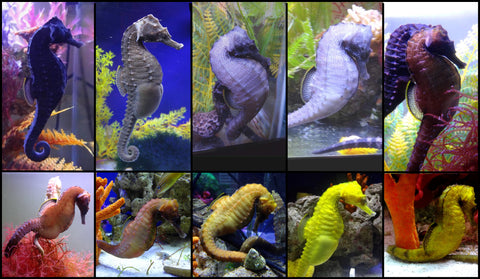Seahorse Color-Color is Not Fixed and Changes

Masters of Camoflage
A common misconception about seahorses regards their color. Color in seahorses is NOT fixed and changes based on mood, surroundings, lighting, diet, age, varies with species and many other factors. Seahorses are masters of camouflage and have the ability to expand and contract their pigment cells in their skin known as chromatophores. The same seahorse can display black, brown, gray, yellow, golden, beige, and other variations of color and pattern. In their natural environment this amazing color changing ability helps the seahorse blend in with surroundings while they sit and wait for food. It also helps them camouflage from predators which is key since they are slow swimming fish.

H. reidi at our farm
Algae Growth on Seahorses
Some species also will grow algae on their skin to help camouflage with their environment. This is very commonly seen in seahorses in their natural environment. Algae growth on the seahorses's skin can sometimes be seen in the aquarium too, especially with brighter lighting. Do not be alarmed if you happen to see algae growing on your seahorse, it is completely harmless. You also do not want to rub it off as this can cause irritation to the skin of your seahorse which could lead to secondary infections. This algae can appear as a dark algae or often times a clear filamentous algae which often appears like a film coating on your seahorse. If you see this occurring with your seahorses you can try lowering your lighting and reduce nutrients (nitrates and phosphates) in the aquarium to let it naturally reduce.

A great example of algae growth on a seahorse. This is an H. erectus seahorse with diatom growth. Photo credit Lucie Arawana.
Seahorses are Individuals
Some seahorses can change color quickly, others may find a color they prefer and rarely change. These color changes can be quite amazing to witness and really add to their personality! Color with seahorses can vary a lot. We see them change color as fast as us moving them from their holding aquarium to a shipping bag. In this case the change is a normal stress response. When seahorses are displaying and courting they also typically show color changes. Males will especially "light up" when showing off to a lady seahorse. Color can also change with age and many other factors.
Above photo is all the SAME individual seahorse displaying a wide range of coloration. As one can see, COLOR IS NOT FIXED and changes can be dramatic. This is an excellent example of a seahorses color changing ability. Photo credit Lucie Arawana of her seahorse Jetlag (species, H. erectus).
Encouraging Brighter Coloration
There are several ways to try to encourage brighter coloration with your seahorses.
1. Utilize warm white lighting rather than a blue or violet oriented spectrum will allow your seahorses to showcase their brighter shades.
2. Install a bright blue aquarium background to promote more vivid colors.
3. Aquascape the aquarium with artificial brightly colored (yellow, orange, pink, and blue) coral inserts rather than dominated with liverock and sand. The typical aquarium with liverock and sand typically encourages beige or dark coloration since this is the color in the aquarium and the seahorses will try to blend in.
4. Maintain stable water quality and reduce stress. Poor water quality and stress can lead to your seahorses displaying a darker coloration.
5. Very bright lighting such as metal hallides can also sometimes make your seahorses have a "sun tan" and may encourage darker coloration. Moderate to low lighting can also help encourage brighter coloration.

H. kuda, commonly called the spotted seahorse, at our farm.
Orange or Red Seahorses?
One of the most common questions we get asked is if we have red or orange seahorses available. Orange and red are not a typical color seahorses display. We have seen and acquired some red and orange wild seahorse breeding stock. In captivity these individuals end up displaying yellow or other coloration fairly quickly. We have spoke with other breeders and they report the same. While not unheard of in captive bred seahorses, the bright red and orange coloration seen in some wild seahorses likely is from natural sunlight, diet or other factors. This is not coloration typically seen in captive kept seahorses.


H. erectus displaying orange coloration. Photo credit Lucie Arawana.
Seahorse Markings
Seahorses have a wide range of beautiful markings which may include saddling, lines, and stars. This varies with individuals and species and often develop more with maturity. We encourage folks to appreciate their individual intricate markings and personality and not get so hung up on color since it is not fixed and unpredictable at times. Hippocampus erectus, commonly called the lined seahorse are some of the most commonly available captive bred seahorses and very hardy. They make great beginner seahorses and in our opinion have some of the most beautiful markings. Seahorses are full of personality, very social animals, beautiful and easy to fall in love with.




There is wide range of colors and markings seahorses display. These are very beautiful, unique and fascinating fish. We hope you find this information helpful and informative. Special thank you to seahorse keeper Lucie Arawana for providing many of the photos in this article. Please reach out to us if you have any questions. We are happy to help and look forward to hearing from you.


